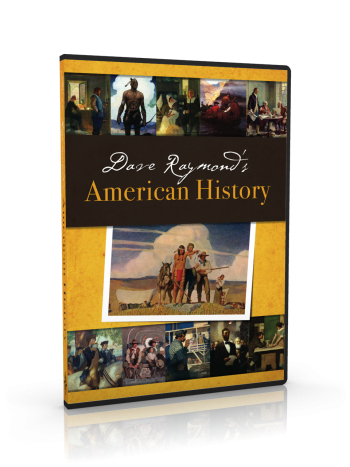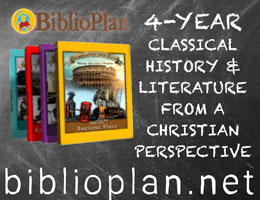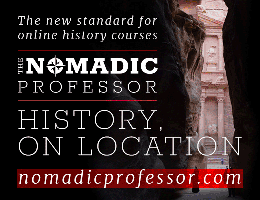Dave Raymond’s American History course for high school surprised me with its comprehensive coverage in both content and course layout. I was prepared for just another set of video snippets on isolated topics from American History. Instead, this course offers complete coverage of American History using a combination of video lesson presentations, student reading assignments, projects, and exams. The videos are also available on DVDs, as downloaded files, or via streaming.
The course covers Meso-America (e.g., the Mayans and the Inca) up through Theodore Roosevelt. Note that this doesn't include modern American history.
The course is premised on a biblical Christian worldview, discussing historical events and cultures in light of worldviews. Raymond presents topics within context rather than in isolation. For example, the Meso-American civilizations all bear some similarities to other ancient civilizations, so Raymond ponders the possibilities of shared roots as far back as the Tower of Babel. He talks about the Aztec god Quetzalcoatl and his likely origin in the person of one of the earliest missionaries.
Raymond stresses the concept fundamental to an understanding of worldviews: ideas have consequences. And he continually demonstrates this throughout the course. For example, he shows that the character and beliefs of George Washington and the other colonial revolutionaries were the critical factors in achieving independence rather than their circumstances or material advantages.
There are 26 lessons in the course, that will take about one week each to complete. A research paper and projects will take additional time. Each lesson has five video presentations, lasting about ten minutes per session. In the videos, Dave Raymond teaches using many illustrations, photos, maps, and other visual aids. He’s an energetic and engaging teacher, so these are fun to watch. Students can always double up on video presentations on a single day if they prefer. The videos lay the groundwork.
Then students read from the Student Reader which is included either as a downloadable file or as a file on the first DVD (your choice of EPUB, MOBI, or PDF versions as well as EPUB and MOBI versions created with a dyslexia-friendly font). Readings in the first half of the course are from primary source documents such as the Declaration of Independence and the Constitution; poems such as “Ticonderoga: A Legend of the West Highlands” by Robert Louis Stevenson; speeches such as “The Rights of the Colonists” by Samuel Adams; letters such as Jonathan Edwards’ account of the Great Awakening in Massachusetts; excerpts from literary works such as The Last of the Mohicans by James Fenimore Cooper; and sermons such as George Whitefield’s “The Method of Grace.” Examples of the readings in the second half of the course are "The Vow of Washington" by John Greenleaf Whittier, George Washington's "Farewell Address," communications between President Thomas Jefferson and the Danbury Baptist Association regarding the division between church and state, "The Defense of the Alamo" by Joaquin Miller, an excerpt from Democracy in America by Alexis DeTocqueville, “The Slavery Question” by John C. Calhoun, "The Fugitive Slave Act of 1850," 13th-15th Amendments to the Constitution, the introduction to Christianity and Liberalism by J. Gresham Machen, an excerpt from Up From Slavery by Booker T. Washington, and “Character and Success” by President Theodore Roosevelt.
Some of these readings will be quite challenging for some students, so parents might need to assist them or adapt assignments. You might assign portions of some of the readings if they seem too long for your student. Some homeschoolers have used this course with students as young as middle school, but with some significant adaptations.
Students are occasionally given a reading assignment from the Bible, generally with questions to ponder and answer. I also noted an occasional online assignment such as: “Research online the life and work of the English cartoonist William Hogarth. How do his illustrations demonstrate the culture of England in the era of the Great Awakening?” (Student Reader, p. 51). There are reading assignments for the first four days of class, then students complete an exam on Friday. Exam questions follow the student reading assignments in the Student Reader so students can see these in advance. In fact, it might make sense to have students read through the questions before watching the video presentations to help them tune into the key information. Raymond instructs students at the very beginning that they should be taking notes as they watch each of the video lectures.
Weekly exams are quite challenging. Questions generally test students on comprehension and understanding of the material presented in the videos and the readings. Some questions require extensive written responses. For example, one question asks, “Describe the character, life, and work of Jonathan Edwards” (Student Reader, p. 66).
Students are to create a portfolio of their work for the course. They should be creating at least three items per lesson (each week), and these should be a mixture of visual and textual entries, all done with care in both content and presentation.
During the first semester, students are to create a detailed copy of a colonial map, researching the history of the map as part of the process. Students also prepare a memorized speech for which they create at least one costume item.
For the second semester, students will complete a research paper and one other project that will require 30 to 40 hours of work. This latter requirement gives me pause since this is quite a lot of time to devote to a single project. However, this might well be a hands-on project—construction, craft work, cooking—or it might be creative writing. If a student chooses a project they enjoy, it shouldn't be a problem, and you might be able to give them simultaneous credit for art or language arts at the same time.
You can see that all of that I have described provides a significant amount of coursework that challenges students on a number of levels. However, students who have already learned how to do independent research should be able to complete most of their coursework on their own.
The Dave Raymond's American History: Teacher’s Guide also comes either as a downloadable file or on the first of the DVDs. The teacher’s guide explains how to use the curriculum, provides record-keeping charts and evaluation assistance, explains the student projects, and serves as your answer key. Since a parent or teacher needs to evaluate student work, key ideas that should be covered on exams are provided in an answer key in the teacher's guide. The parent or teacher should at least watch the videos to be equipped to evaluate student work even if he or she doesn’t have time to complete all of the reading. The teacher's guide, as well as the Student Reader and exams, are also available in printed format if needed.
In my opinion, this course offers an excellent balance of interesting video lectures, serious reading, and challenging writing coupled with worthwhile portfolio and project work, all presented from within a Christian worldview.
You can download free sample lessons at the publisher’s website by clicking here.













